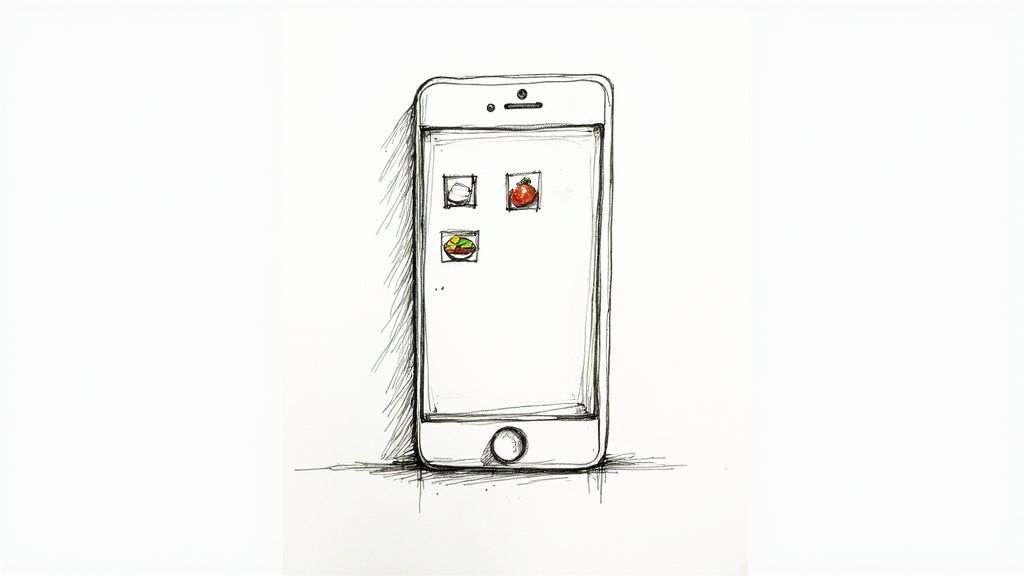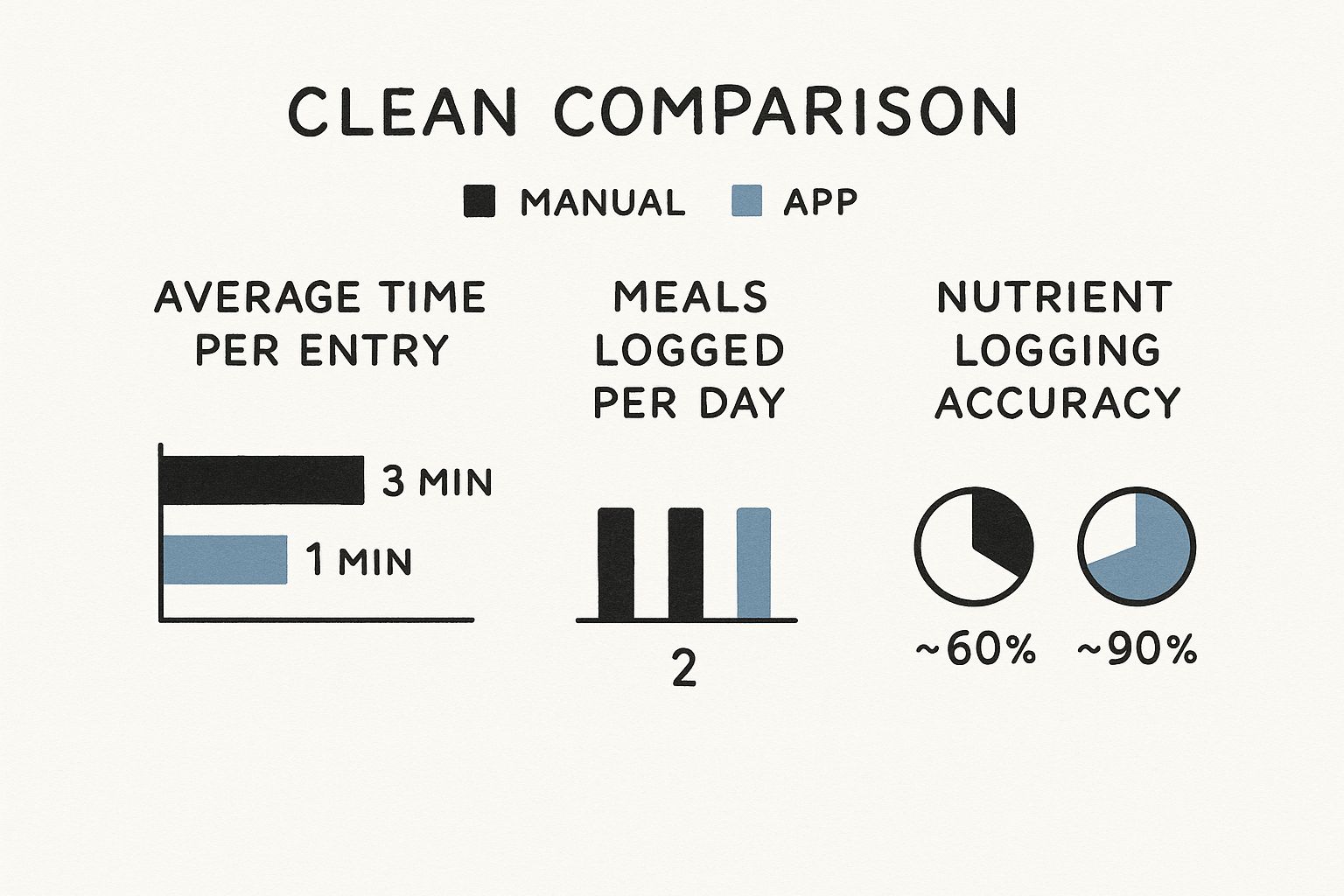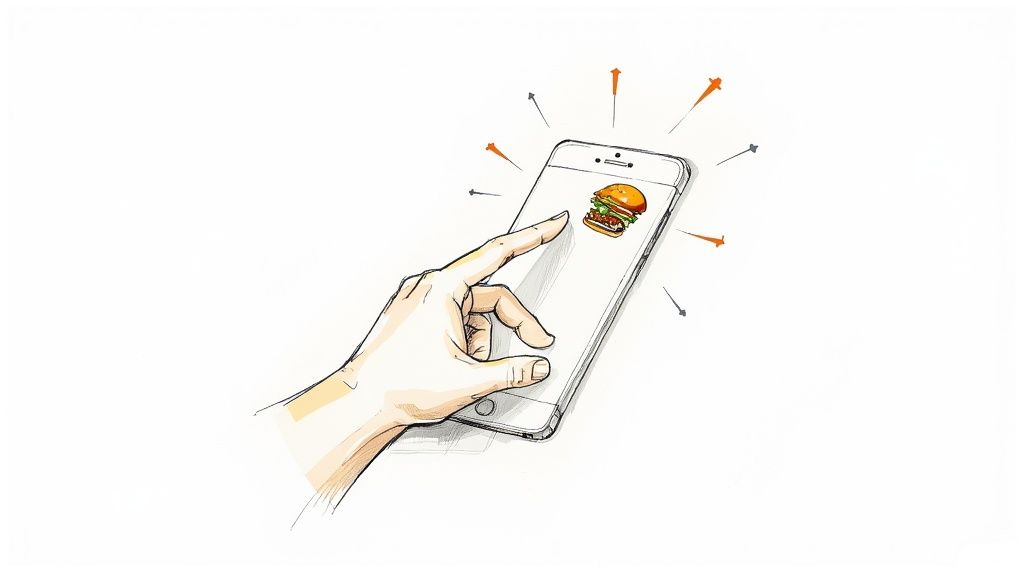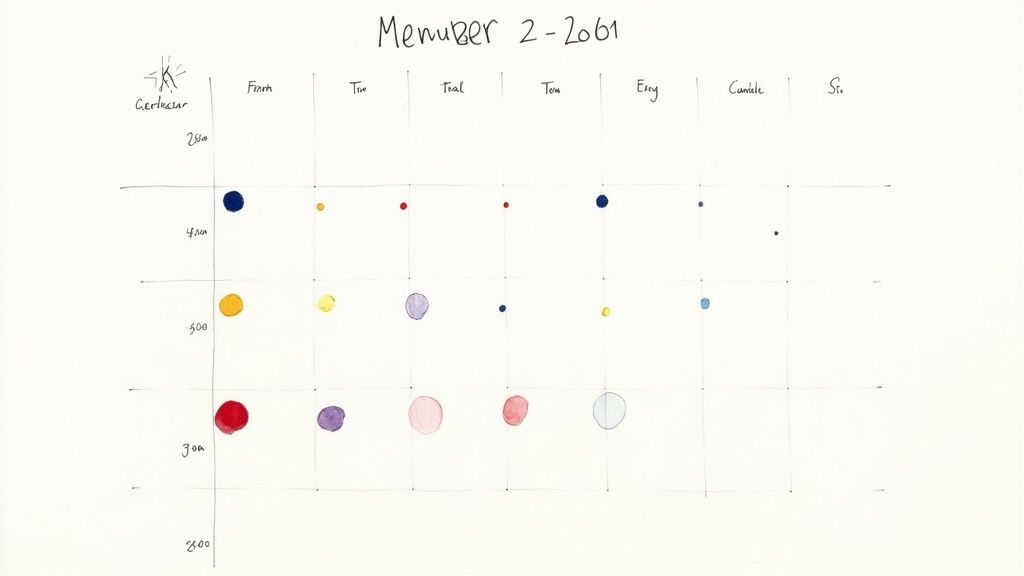Find a Simple Food Diary App That Actually Works
Tired of tedious tracking? Discover what makes a simple food diary app truly effortless and how AI voice logging can transform how you see nutrition.
Posted by
At its core, a simple food diary app is a tool that helps you track what you eat with as little fuss as possible. Many of these apps use features like voice logging to make the whole process feel fast and natural. The real goal is to build awareness of your eating habits, not to create an obsession with numbers.
What Makes a Food Diary App Truly Simple?
Let’s be honest, a lot of apps that claim to be “easy” for food tracking end up feeling like a part-time job. They’re cluttered with endless menus, confusing manual calculations, and barcode scanners that mysteriously fail on your go-to snacks. A genuinely simple food diary app throws all that complexity out the window for a more intuitive, stress-free experience.
The point isn't to get a perfect, lab-grade analysis of every single meal. It’s more about creating a casual, consistent habit of paying attention to what you eat. When an app is simple, it fits into your life, not the other way around. Logging your lunch should be as quick and easy as sending a voice note to a friend.
Redefining Effortless Tracking
True simplicity in a food diary really boils down to a few key ideas. The focus shifts away from tedious data entry and toward effortless awareness. It’s all about removing the little annoyances that make most of us quit tracking after just a few days.
A modern, simple app should let you:
- Log meals in seconds, not minutes: You shouldn't have to stop what you're doing to wrestle with complex menus. A quick voice command like, "I had a bowl of oatmeal with blueberries and a coffee for breakfast," should be all it takes.
- Focus on the big picture: Instead of getting bogged down in every last micronutrient, the app should give you a clear, quick look at your daily calories, protein, carbs, and fat. This helps you make small, smart adjustments as you go.
- Feel encouraged, not judged: The design should feel clean and supportive. No glaring red warnings for going over a target or nagging notifications if you miss an entry. It's a tool for your own insight, not a strict rulebook.
The guiding principle of a simple food diary is that awareness shouldn't feel like hard work. The easier it is to log your food, the more consistent you’ll be—and that consistency is what really leads to meaningful change.
Imagine getting to the end of your day and logging everything you ate—your morning coffee, a homemade salad, and that handful of almonds you grabbed between meetings—in less than 60 seconds just by talking. That's the new standard for "simple." This approach makes mindful eating something anyone can do, no matter how packed their schedule is, by turning tracking into a background habit instead of a chore.
The Real-Life Benefits of Casual Food Tracking

So, why bother keeping a food diary if you aren't on some super-strict diet? The magic of casual tracking isn't about restriction; it's all about awareness. Simply paying a little attention to what you eat, without the pressure to be perfect, can unlock some powerful and surprising benefits.
Think of it less like a report card you’re being graded on and more like a friendly chat with yourself about your day. This low-stress mindset shifts food logging from a chore into a tool for mindfulness. You’re not obsessing over every last calorie, just creating a simple record to help you connect the dots between your food choices and how you actually feel.
Uncovering Your “Aha” Moments
Sometimes the biggest changes begin with the smallest realizations. Using a simple food diary app can shine a light on patterns you’d never have noticed otherwise, leading to those "aha" moments that help your habits shift naturally.
For instance, you might suddenly see:
- The Sneaky Sugars: That daily flavored latte you love? You might find it has more sugar than the dessert you have once a week. Just seeing that can make you think, "Hey, maybe I'll ask for half the syrup next time," no major willpower struggle required.
- The Protein Gap: You hit that 3 p.m. slump, glance at your log, and notice you've barely had any protein. That simple insight might steer you toward a Greek yogurt or a handful of almonds instead of chips, keeping you fuller for longer.
- The Hydration Connection: You might think you drink plenty of water, but logging your beverages could reveal you're not even close. That awareness is often the only nudge you need to start keeping a water bottle at your desk.
None of these are massive, life-altering changes. They're just small, informed decisions that stack up over time, boosting your energy and sense of well-being. It’s all about making smarter choices more instinctively because you finally have the full picture.
Casual food tracking is about connecting with your body, not just counting numbers. It empowers you to understand what fuels you best, leading to better energy and more intuitive food choices without the stress of a diet.
From Awareness to Effortless Action
This kind of gentle tracking builds a much stronger connection between your plate and your mood. When you log that heavy lunch and later jot down that you felt sluggish and foggy, you start drawing a direct line between the two. Do that a few times, and those observations become second nature.
This is exactly where voice logging with an app like munchlog.ai changes the game. When all it takes is saying, "I had a chicken salad for lunch," you're creating a habit with almost zero friction. That ease of use is what helps you stick with it long enough to actually see these benefits unfold. The goal isn't perfection; it's building a sustainable habit of mindfulness, one meal at a time.
What To Look For in an Effortless Food Diary App
When you just want to get a handle on your eating habits, the right tool can make or break your success. Let's be honest, not all food diary apps are built the same. Many are cluttered with so many confusing features that they create more stress than they solve. A truly simple food diary app should feel like an assistant, not a drill sergeant.
The demand for better tools is exploding. People are fed up with the old, clunky ways of tracking what they eat. The global food tracker app market, valued at around $1.2 billion, is projected to soar to nearly $3.5 billion by 2033. This isn't just a trend; it's a clear signal that people want apps that make nutrition awareness genuinely easier.
Speed and Simplicity Come First
The number one feature of an effortless food diary is speed. If logging your lunch takes longer than eating it, you’re not going to stick with it. It’s that simple. This is where modern apps shine, focusing on quick, seamless entry that doesn't interrupt your day.
Look for these key time-savers:
- Voice Logging: The ability to just say what you ate—like, "I had a chicken Caesar salad and an apple for lunch"—is a complete game-changer. It cuts out all the tedious searching, measuring, and tapping through menus.
- Intelligent Food Recognition: A smart app should understand how people actually talk about food. It needs to know that "a handful of almonds" is a portion size and that "my usual morning coffee" is your go-to latte with oat milk, remembering from past entries.
- Clean, Simple Interface: The app should show you the important stuff—calories, protein, carbs, and fat—in a clear, straightforward summary. No confusing graphs or judgmental colors, just the data you need.
Let’s break down just how much of a difference this modern approach makes compared to the old-school manual methods.
Traditional Food Logging vs Simple AI Food Logging
| Feature | Traditional App Experience | Simple AI App Experience (munchlog.ai) |
|---|---|---|
| Data Entry Method | Manual typing, barcode scanning, endless database searches. | Speak or type in natural language. |
| Time to Log a Meal | 3-5 minutes per meal, often longer for complex recipes. | Under 30 seconds per meal. |
| Handling Homemade Meals | Requires you to enter every single ingredient and portion size. | Simply describe the meal (e.g., "a bowl of my beef stew"). |
| Learning Curve | High. Navigating complex interfaces and databases is frustrating. | Low. It's as easy as talking to a friend. |
| Consistency | Often sporadic due to the high effort required; easy to fall behind. | High. Quick logging makes it easy to stay consistent every day. |
The takeaway here is pretty clear. The right app doesn't just cut down the time it takes to log a meal; it improves your consistency and the accuracy of your data, making the whole process more effective and sustainable in the long run.

Must-Have Features for Real Life
Beyond just being fast, a great app has to be flexible enough for real life. Our meals aren't always neatly packaged with a barcode on the side. A genuinely useful tool has to keep up with the beautiful chaos of real-world eating.
The best food diary app is the one you actually use. It needs to handle everything from your quick morning smoothie to a complex homemade dinner without making you feel like you're solving a puzzle.
This is exactly why features that can handle real-world scenarios are non-negotiable. For instance, the app must let you log a homemade meal like "a bowl of my beef stew" and use its AI to give you a solid nutritional estimate. This alone removes one of the biggest headaches of traditional tracking.
For those who want to get a bit more granular, our guide on how to track macros dives deeper into getting these numbers right without all the hassle. At the end of the day, the goal is to find a tool that delivers valuable insights with the least amount of effort.
How AI Makes Your Food Diary Smarter, Not Harder

The term "AI" might conjure up images of sci-fi movies, but in a simple food diary app, it just has one job: to do the heavy lifting for you. Think of it less like a robot and more like a smart nutrition assistant who gets to know you, making the whole process of tracking your food feel less like a chore and more like a quick chat.
Its real magic is in understanding how people actually talk about food. Instead of forcing you to scroll through endless lists or scan barcodes, AI lets you log what you ate using natural, everyday language. This small shift makes a massive difference when it comes to staying consistent.
Your Personal Food Translator
The best part about an AI-powered food diary is its ability to learn your personal habits. After just a handful of entries, the app starts picking up on your routines, which makes logging future meals even faster.
For example:
- It remembers your favorites: The fifth time you say "my morning coffee," the app knows you mean a large latte with oat milk and one pump of vanilla. It just logs it for you, no need to specify every single detail again.
- It understands real-world portions: Let's be honest, you don’t always use measuring cups. A smart app can translate phrases like "a handful of almonds" or "a splash of milk" into realistic portion estimates, giving you a solid idea of your intake without needing a food scale.
- It deciphers complex meals: Logging a homemade stew used to be a nightmare of entering every last carrot, spice, and ounce of broth. Now, you can just say, "I had a bowl of my beef and veggie stew," and the AI calculates a remarkably accurate nutritional estimate on your behalf.
This intelligent way of working is what transforms food tracking from a rigid, time-sucking task into a simple, sustainable habit.
An AI-powered food diary isn't just about logging faster; it's about getting a more accurate, personalized picture of your nutrition with way less effort. It works for you, not the other way around.
From Voice to Valuable Insights
At the end of the day, AI is the engine that makes a simple food diary app truly effortless. By understanding your voice, your phrasing, and your go-to meals, it quietly crunches all the numbers in the background. It takes your spoken words and turns them into a clear summary of your calories, protein, carbs, and fat for the day.
This frees you up to focus on the big picture—like making sure you’re getting enough protein or seeing how certain foods impact your energy levels. The AI does the hard work, giving you the insights you need to make small, positive changes without all the stress.
Logging Your Real Life, From Coffee to Cocktails

A food diary is only as good as the life it reflects—and let's be honest, life is often messy, spontaneous, and delicious. Real consistency isn't about eating perfectly measured, "clean" meals every single day. It’s about having a tool that can actually keep up when your plans go sideways.
A truly simple food diary app should feel like it's barely there, slotting into your day whether you’re grabbing coffee on the run or enjoying a well-deserved night out with friends.
The whole point is to make logging so fast it never feels like a chore. This is where voice completely changes the game. You don't have to pause your life just to document it. Just speak your meal into existence in a few seconds, and you can get right back to living.
From Morning Rush to Homemade Meals
Let's see what this looks like on a typical day. Most of us eat a mix of planned meals and whatever-is-available snacks, and your app needs to handle all of it without a fuss.
- The Morning Coffee: You’re rushing out the door and grab your usual latte. Forget scrolling through endless menus. Just say, “I had a large oat milk latte.” The app’s AI figures out the components, gives you a solid estimate of the macros, and you’re done before the barista even shouts your name.
- The Complex Homemade Salad: For lunch, you tossed together a salad with what feels like a dozen different ingredients. Instead of painstakingly entering every single item, you can just list them off: “I had a big salad with chicken, avocado, tomatoes, cucumber, and vinaigrette.” The AI does the heavy lifting of calculating the nutrition for you.
- The Afternoon Vending Machine Trip: That 3 p.m. slump hits, and you find yourself in front of the vending machine. A quick voice entry—“I ate a small bag of pretzels”—takes two seconds and keeps your log honest, without any judgment.
This kind of convenience is exactly what people are looking for. The diet and nutrition app market was valued at USD 2.14 billion and is expected to climb to USD 4.56 billion by 2030. With smartphones making up 67% of the platform share, it's clear that mobile-friendliness and ease of use are non-negotiable.
Socializing Without the Stress
Let’s talk about one of the biggest reasons people give up on tracking: it feels awkward and antisocial. Nobody wants to be the person at the dinner table pecking away at their phone, trying to guess the calories in their pasta dish. Voice logging flips this script entirely.
A simple food diary should adapt to your social life, not interrupt it. Effortless logging means you can stay present with the people you care about while still keeping your personal goals in sight.
Imagine you're out for dinner and drinks on a Friday night. You can discretely log your meal and cocktail by speaking into your phone for a moment, or even just make a mental note and log it when you get home. A quick entry like, “I had a margarita and three tacos with steak and guacamole,” is all it takes. The app provides a good-enough estimate, keeping you on track without forcing you to sacrifice your social life.
For those times you do want more precision without all the hassle, our guide on how to weigh food for weight loss has practical tips that still work for a busy lifestyle. In the end, it's all about finding that sustainable balance where tracking supports your life instead of controlling it.
Your Questions on Simple Food Tracking Answered
Jumping into a new habit, even a simple one, always brings up a few questions. If you're curious about using a simple food diary app but have some reservations, you're not alone. Let's tackle some of the most common concerns to help you get started with confidence.
The point of this isn't to add another complicated task to your day. It's about finding a smooth, easy way to become more mindful of what you're eating.
Do I Have to Log Every Single Thing Perfectly?
Absolutely not. This is probably the biggest myth about food tracking, and it’s the hurdle that trips most people up. The purpose of a casual food diary is to build awareness, not to achieve some kind of scientific perfection.
Think of it like the 80/20 rule. If you capture most of what you eat on most days, you'll still gain incredible insights into your habits. Forgetting a snack here and there or just estimating a portion size is perfectly fine. A modern app is designed for real life, where things aren't always measured down to the last gram. Consistency over perfect accuracy is always the key.
Will Using a Food Diary Make Me Obsessed with Food?
That's a valid concern, and it’s precisely why choosing a simple app matters so much. Traditional apps, with their streaks, scores, and red warning colors for "bad" foods, can definitely encourage obsessive behavior.
A more casual app like munchlog.ai is designed specifically to prevent this. When you use your voice, logging becomes a quick, neutral action—more like sending a text message than sitting down for an intense analysis session. It's built to be a tool for mindfulness, not micromanagement. The whole idea is to spend less than a minute a day logging so you can get back to actually living your life.
What if I Eat a Lot of Homemade Meals?
This is where modern, AI-powered apps really shine. Older apps made you manually enter every single ingredient and its weight, which is exactly why so many people quit. It was a massive pain.
With a simple AI app, you can just describe your meal naturally, like "a bowl of my homemade chicken soup" or "two slices of mom's lasagna." The AI is smart enough to approximate the nutritional info from a huge database of recipes. This saves you an enormous amount of time and makes it practical to log the food you actually cook and enjoy.
A simple food diary should fit into your life, not the other way around. Whether it's a quick snack or a complex family recipe, logging it should always feel effortless.
Can I Keep Up with a Food Diary if My Schedule Is Chaotic?
Yes, in fact, a simple food diary is perfect for an unpredictable schedule. Because it only takes seconds to log a meal with your voice, you can do it anywhere—walking to a meeting, in the car (hands-free), or while waiting for the elevator.
The flexibility of voice logging allows it to fit into the small gaps of a busy day, which is what makes it a sustainable habit for almost anyone. This kind of adaptability is also driving huge growth in the industry, with the diet and nutrition apps market projected to reach USD 5.76 billion. Employers are even getting on board, incorporating digital nutrition tools into wellness programs for their busy teams. You can read more about these market trends and their growth.
Ready to see how simple food tracking can be? Stop typing and start talking with munchlog.ai. Get your effortless food diary started today at https://www.munchlog.ai.